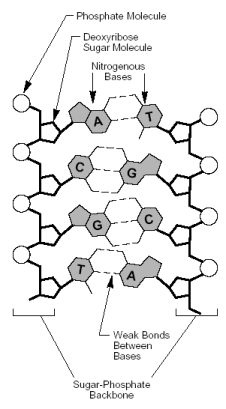

BLAIR DNA Project

DNA 103: Grouping Participants
DNA 101: Y-Chromosome Testing
DNA 101 is the first in a series of three articles that attempt to take the extremely complex and confusing subject of Genetics and DNA and simplify it into layman terms. These articles addresses DNA only as it applies to Y-Chromosome testing and genealogy. Technical terms are defined in this same context.
DNA 101 discusses the basics of DNA and the Y-Chromosome and how they apply to genealogy.
DNA 102 discusses Interpreting DNA Test Results.
DNA 103 discusses the methods I use in the Blair DNA Project to group participants after receiving their test results.
DNA 101 is broken down into the following sections:
DNA
Chromosomes
The Y-Chromosome
Test the Y-Chromosome
Reading the Test Results
DNA 102: Interpreting DNA Test Results
Definitions
Links
Deoxyribonucleic acid (DNA) is the chemical inside the nucleus of all cells that carries the genetic instructions for making living organisms. A DNA molecule consists of two strands that wrap around each other to resemble a twisted ladder. The sides are made of sugar and phosphate molecules. The �rungs� are made of nitrogen-containing chemicals called bases. Each strand is composed of one sugar molecule, one phosphate molecule, and a base. Four different bases are present in DNA - adenine (A), thymine (T), cytosine (C), and guanine (G). The particular order of the bases arranged along the sugar - phosphate backbone is called the DNA sequence; the sequence specifies the exact genetic instructions required to create a particular organism with its own unique traits.
Each strand of the DNA molecule is held together at its base by a weak bond. The four bases pair in a set manner: Adenine (A) pairs with thymine (T), while cytosine (C) pairs with guanine (G). These pairs of bases are known as Base Pairs (bp).
These Base Pairs (bp) are the basis of Y-chromosome testing.
Chromosomes are paired threadlike "packages" of long segments of DNA contained within the nucleus of each cell. In humans there are 23 pairs of chromosomes. In 22 pairs, both members are essentially identical, one deriving from the individual's mother, the other from the father. The 23rd pair is different. In females this pair has two like chromosomes called "X". In males it comprises one "X" and one "Y," two very dissimilar chromosomes. It is these chromosome differences which determine sex.
Human sex is determined by the X and Y chromosomes. A female has 2 X-Chromosomes and a male has an X and a Y-Chromosome. When a child is conceived it gets one chromosome from its mother and one chromosome from its father. The chromosome from the mother will always be an X, but the chromosome from the father may be either X or Y. If the child gets the X she will be a girl, if the child gets the Y he will be a boy.
This Y-Chromosome has certain unique features:
-
The presence of a Y-Chromosome causes maleness. This little chromosome, about 2% of a father's genetic contribution to his sons, programs the early embryo to develop as a male.
-
It is transmitted from fathers only to their sons.
-
Most of the Y-Chromosome is inherited as an integral unit passed without alteration from father to sons, and to their sons, and so on, unaffected by exchange or any other influence of the X-Chromosome that came from the mother. It is the only nuclear chromosome that escapes the continual reshuffling of parental genes during the process of sex cell production.
It is these unique features that make the Y-Chromosome useful to genealogists.
The Y-Chromosome has definable segments of DNA with known genetic characteristics. These segments are known as Markers. These markers occur at an identifiable physical location on a chromosome known as a Locus. Each marker is designated by a number (known as DYS#), according to international conventions. You will often find the terms Marker and Locus used interchangeably, but technically the Marker is what is tested and the Locus is where the marker is located on the chromosome.
Although there are several types of markers used in DNA studies, the Y-Chromosome test uses only one type. The marker used is called a Short Tandem Repeat (STR). STRs are short sequences of DNA, (usually 2, 3, 4, or 5 base pairs long), that are repeated numerous times in a head-tail manner. The 16 base pair sequence of "gatagatagatagata" would represent 4 repeats of the sequence "gata". These repeats are referred to as Allele. The variation of the number of repeats of each marker enables discrimination between individuals.
The table below is a shorten version of the actual table used to show our DNA test results. It shows 12 of the 25 markers that most of the participants had tested.

The numbers (1-12) across the top of the table are the marker numbers. They have no significance other than as an easy way to refer to the marker. Note: FamilyTree DNA refers to these numbers as Locus. The second set of numbers across the top of the matrix are DYS# (the actual marker names).
The numbers down the left side of the table identify the participant in the DNA project. The numbers down the right side of the table identify the participant's oldest known ancestor.
The rest of the numbers are the Allele (the number repeats) for
each participant at the specified marker.
DNA 102: Interpreting DNA Test Results
Allele: One of the variant forms of a gene at a particular locus, or location, on a chromosome. Different alleles produce variation in inherited characteristics. For STR markers, each allele is the number of repeats of the short base sequence.
Base Pair: Two bases that form a "rung of the DNA ladder." A DNA nucleotide is made of a molecule of sugar, a molecule of phosphoric acid, and a molecule called a base. The bases are the "letters" that spell out the genetic code. In DNA, the code letters are A, T, G, and C, which stand for the chemicals adenine, thymine, guanine, and cytosine, respectively. In base pairing, adenine always pairs with thymine, and guanine always pairs with cytosine.
Chromosome: One of the threadlike "packages" of genes and other DNA in the nucleus of a cell.
DNA: The chemical inside the nucleus of a cell that carries the genetic instructions for making living organisms.
DYS#: D=DNA, Y=Y chromosome, S=a unique DNA segment. A label for genetic markers on the Y chromosome. Each marker is designated by a number, according to international conventions. At present, virtually all the DYS designations are given to STR markers (a class often used in genetic genealogy).
Gene: The functional and physical unit of heredity passed from parent to offspring. Genes are pieces of DNA, and most genes contain the information for making a specific protein.
Genome: All the DNA contained in an organism or a cell, which includes both the chromosomes within the nucleus and the DNA in mitochondria.
Locus: A point in the genome, identified by a marker, which can be mapped by some means. It does not necessarily correspond to a gene. A single gene may have several loci within it (each defined by different markers) and these markers may be separated in genetic or physical mapping experiments. In such cases, it is useful to define these different loci, but normally the gene name should be used to designate the gene itself, as this usually will convey the most information.
Marker: Also known as a genetic marker, a segment of DNA with an identifiable physical location on a chromosome whose inheritance can be followed. A marker can be a gene, or it can be some section of DNA with no known function. Because DNA segments that lie near each other on a chromosome tend to be inherited together, markers are often used as indirect ways of tracking the inheritance pattern of genes that have not yet been identified, but whose approximate locations are known.
Microsatellite: Repetitive stretches of short sequences of DNA used as genetic markers to track inheritance in families.
Mutation: A permanent structural alteration in DNA.
Short Tandem Repeats (STR): A genetic marker consisting of multiple copies of an identical DNA sequence arranged in direct succession in a particular region of a chromosome. Occasionally, one will mutate by the gain or loss of one repeat. (Also known as microsatellite)
International Society of Genetic Genealogy (ISOGG) - The first society founded to promote the use of DNA testing in genealogy! With links to a wealth of genetic genealogy tools and information.
Contexo.Info A website about the foundations of molecular genetics and biology. An excellent site for those who are looking more details on DNA.
The National Human Genome Research Institute - The National Human Genome Research Institute (NHGRI) created the Talking Glossary of Genetic Terms to help people without scientific backgrounds understand the terms and concepts used in genetic research.
Human Genome Project Information - The Human Genome Project (HGP) is an international effort to discover all the approximately 30,000 to 35,000 human genes (the human genome), make them accessible for further biological study, and determine the complete sequence of the 3 billion DNA subunits (bases).
Primer on Molecular Genetics - This primer was prepared by Denise Casey, Human Genome Management Information System, Oak Ridge National Laboratory, for the 1991-92 DOE Human Genome Program Report.
Primer on Molecular Genetics (pdf format) - This is an adobe version of the primer above.
Why Y? The Y Chromosome in the Study of Human Evolution, Migration and Prehistory - Neil Bradman and Mark Thomas of The Centre for Genetic Anthropology at University College London reveal the power of modern genetic analysis for exploring the role of fathers in human history.
Genetics & Genealogy: Y Chromosome DNA and the Y Line - by Thomas H. Roderick, PhD, Center for Human Genetics. A discussion of the Y-Chromosome and its role in DNA as tool for genealogists.
Short Tandem Repeat DNA Internet DataBase - While the use of STRs for genetic mapping and identity testing has become widespread among DNA typing laboratories, there is no single place where information may be found regarding STR systems. This web site is an attempt to bring together the abundant literature on the subject in a cohesive fashion to make future work in this field easier. Facts and sequence information on each STR system, population data, commonly used multiplex STR systems, PCR primers and conditions, and a review of various technologies for analysis of STR alleles have been included in this database.
GENEALOGY-DNA-L - This mailing list is for anyone with DNA (i.e., anyone!) who would like to discuss methods and share results of DNA testing as applied to genealogical research.
Genetic Genealogy and Telephone Tag - A simplified explanation of how Y-DNA mutates.
To start your own Surname DNA Project click below
|
� July 12, 2010, blairdna.com |
This WebPage was last updated 04/05/2015
|
Custom Web Search Search Genealogy, DNA, and Genetic Genelogy websites |
|
Custom Web Search Search Genealogy, DNA, and Genetic Genelogy websites |
| Contact the Blair DNA Project Coordinator |
© January 1, 2010, blairdna.com

God Bless
America
and its Allies
